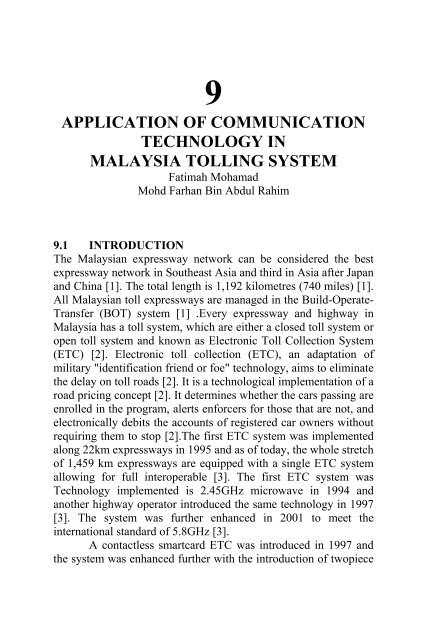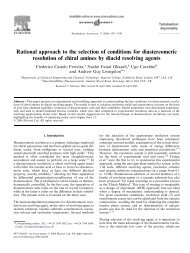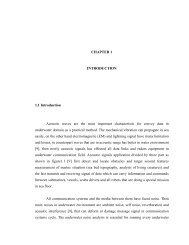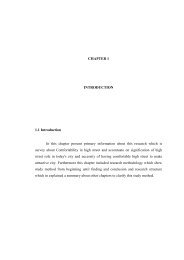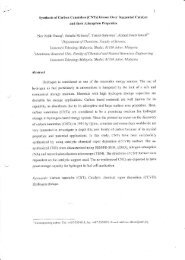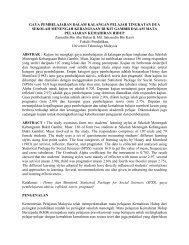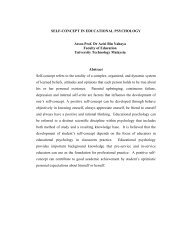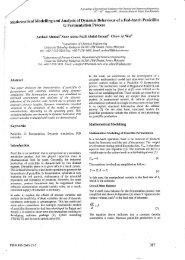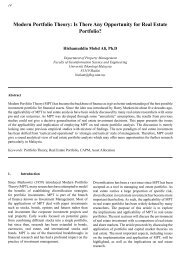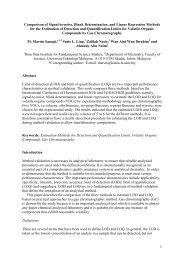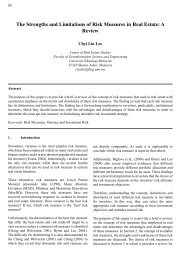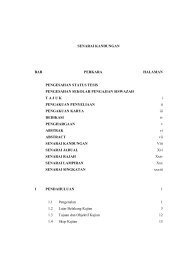PDF (Fulltext)
PDF (Fulltext)
PDF (Fulltext)
You also want an ePaper? Increase the reach of your titles
YUMPU automatically turns print PDFs into web optimized ePapers that Google loves.
9<br />
APPLICATION OF COMMUNICATION<br />
TECHNOLOGY IN<br />
MALAYSIA TOLLING SYSTEM<br />
Fatimah Mohamad<br />
Mohd Farhan Bin Abdul Rahim<br />
9.1 INTRODUCTION<br />
The Malaysian expressway network can be considered the best<br />
expressway network in Southeast Asia and third in Asia after Japan<br />
and China [1]. The total length is 1,192 kilometres (740 miles) [1].<br />
All Malaysian toll expressways are managed in the Build-Operate-<br />
Transfer (BOT) system [1] .Every expressway and highway in<br />
Malaysia has a toll system, which are either a closed toll system or<br />
open toll system and known as Electronic Toll Collection System<br />
(ETC) [2]. Electronic toll collection (ETC), an adaptation of<br />
military "identification friend or foe" technology, aims to eliminate<br />
the delay on toll roads [2]. It is a technological implementation of a<br />
road pricing concept [2]. It determines whether the cars passing are<br />
enrolled in the program, alerts enforcers for those that are not, and<br />
electronically debits the accounts of registered car owners without<br />
requiring them to stop [2].The first ETC system was implemented<br />
along 22km expressways in 1995 and as of today, the whole stretch<br />
of 1,459 km expressways are equipped with a single ETC system<br />
allowing for full interoperable [3]. The first ETC system was<br />
Technology implemented is 2.45GHz microwave in 1994 and<br />
another highway operator introduced the same technology in 1997<br />
[3]. The system was further enhanced in 2001 to meet the<br />
international standard of 5.8GHz [3].<br />
A contactless smartcard ETC was introduced in 1997 and<br />
the system was enhanced further with the introduction of twopiece
Application of Communication Technology in Malaysian 97<br />
Tolling System<br />
On-Board-Unit for ETC in 1998 [3]. This system later adopted as<br />
the ‘single ETC’ system for Malaysia [3].<br />
9.2 THE COMPOSITION AND PRINCIPLE OF ETC<br />
SYSTEM<br />
Wireless communication and information change can be done with<br />
ETC systems by the device fixed in the vehicle and road head<br />
device which was fixed in the toll station’s roadway. [4]. It<br />
composes by automatic vehicle identification system, centre<br />
control system and other ancillary facilities [4].<br />
The system of automatic identification vehicle is composed<br />
by on board unit, road side unit, loop sensor and other components<br />
and the centre control system is consisted of large database and the<br />
information of enrolled vehicles and users [4].<br />
When vehicle pass the toll station gob, loop sensor<br />
apperceive the vehicle; RSU sends out question signal; then OUB<br />
responds and done two-way communication and data will<br />
exchange [4]. Identify vehicle information will fetch by centre<br />
control system like as car’s ID and car’s module and after that it<br />
will compare these information to the database [4].<br />
According to situation, it controls the centre manager<br />
system do different operation [4]. Such as computer charge<br />
manager system deducts these travelling expenses from his bank<br />
count or send instruct to other assistant establishment [4]. That<br />
realizes automatism management to running vehicle. Other<br />
assistant establishment mainly closed camera system of breaking<br />
vehicle, control railings, traffic instructions to the traffic equipment<br />
(As red lights, green lights, yellow lights) [4].
98 Wireless Communication Technology in Malaysia<br />
Figure 9.1 The principle of ETC system<br />
9.3 DESIGN OF VEHICLE’S AUTOMATIC<br />
IDENTIFICATION SYSTEM<br />
Vehicle’s identify is the core technology to realize the system of<br />
electronic toll collection [4]. It’s the technology which can identify<br />
the vehicles passed without any action adopted by the driver or<br />
observer, when vehicles passing the especial dot [4]. It can be<br />
applied not only in highway’s electronic toll collection system, but<br />
also in highway’s transport such as navigation, especially in<br />
highway’s transport, there is wide and latent applied foreground<br />
[4]. The process of vehicle’s automatic identify is: when a vehicle<br />
passes the Read module in roadside, the dual-board transceiver
Application of Communication Technology in Malaysian 99<br />
Tolling System<br />
being triggered, and launches codes can only show vehicle’s<br />
identity, the retrieval unit antenna receives and transmit<br />
information to the Read module, so the deferent module to be<br />
checked for completeness and then transmitted to the computer<br />
system for data-processing and storage [4]. The complex system<br />
with twoway communications also can transmit the data back to<br />
the vehicle by the antenna [4].There are several major vehicles’<br />
identification technologies like Optical and infrared AVI systems,<br />
ICP AVI system, RF and microwave AVI systems, SAW and<br />
Image Processing AVI System [4].<br />
9.3.1 Optical and infrared AVI systems<br />
This system uses a signs code labels similar to the bar code label<br />
which installed in a vehicle outside [4]. The information from the<br />
vehicle identity is showed by a series of width or colour changed<br />
lines, said that when the vehicles after capturing modules, and the<br />
different number and colours of light to be reflected on the Read<br />
module, which automatically analyzes the<br />
uniquenessidentification, the identity of the vehicle to show<br />
identification code information [4].<br />
9.3.2 ICP AVI system<br />
This system uses inductively coupling to transmit the data [4].The<br />
roadside Read module regards the conventional loop as antenna,<br />
which used to transmit signal to the vehicles from roadside Read<br />
module or opposition [4]. The inductance dual-board transceiver<br />
uses simple loop or ferrite inspected haulm to be antenna, the<br />
antenna size is related with the wavelength of communication [4].<br />
9.3.3 RF and microwave AVI systems<br />
RF and microwave technology is the basis for some of automatic<br />
vehicle identification system [4]. It uses microwave technology to<br />
achieve the transmission of data codes [4]. Vehicle dual-board
100 Wireless Communication Technology in Malaysia<br />
transceiver is capable of transmitting or receiving electric wave<br />
frequency range of 1000 Hz, trillion Hz and kilo mega Hz [4].<br />
The advantage of microwave system is that it can detect the<br />
data which transmitted by the rate much higher than the rate of<br />
ICP-ring detection, by this, it increases the volume of data the<br />
system can handle [4]. For the antenna size is related with the<br />
wavelength used, the microwave transceiver is smaller than ICP<br />
transceiver in dimension [4].<br />
9.3.4 SAW<br />
SAW is the technical foundation for the identification system<br />
developed in recent years [4]. A SAW systems is composed by a<br />
vehicle tag, one RF Read module and one signal processing<br />
module, the signal processing module is used to translate code<br />
labels and components to the information transmitted to computer<br />
[4].<br />
9.3.5 Image Processing AVI System<br />
The Image Processing AVI System is composed by the camera<br />
(CCD), image card and computer processing system [4]. The<br />
image incepted by CCD, after APD conversion, will be transmitted<br />
to the computer system for image pre-treatment and identification,<br />
the content of identification generally include license plate<br />
numbers, car models or colours [4]. Because electronic toll<br />
collection system requires very high reliability of communications,<br />
it requires almost 100% reliable and all-weather, at the same time,<br />
high data transmission rate is requires to ensure that the real-time<br />
identification [4]. There is many advantages using Electronic Toll<br />
Collection (ETC) unlike other ITS technology, ETC is not<br />
dependent on the implementation of new, advanced technical<br />
systems or an integrated infrastructure to be successful [3].
Application of Communication Technology in Malaysian 101<br />
Tolling System<br />
9.4 SATELLITE TECHNOLOGY IN ETC<br />
The pioneering endeavour by Toll Collect based on GPS/GSM<br />
(Global Positioning System/ Global system for Mobile<br />
Communication) for Road User Charging Systems, is the<br />
awakening for a new era of satellite technology in toll collection<br />
[5]. The market for Road User Charging Systems has been<br />
dominated by ETC (Electronic Tolling Collection System) for a<br />
prolonged timeline. The most renowned technologies for charging<br />
road users range from manual, automatic to DSRC based electronic<br />
toll collection [5]. The Dedicated Short Range Communication<br />
(DSRC) frequency is a dominant technology used for electronic<br />
toll collection systems [5]. The system although dominant,<br />
experienced shortcomings of incurring high investment costs and<br />
land space requirements to set up beacons on every entry and exit<br />
point of a toll road. The DSRC technology also renders difficulties<br />
of having a huge infrastructure requirement in case of distance<br />
based road user charging for longer routes. Toll Collect’s new<br />
satellitebased ETC, which entails the satellite based tolling could<br />
be seen as a feasible solution for the challenge in reducing these<br />
infrastructural costs. This new satellite-based ETC by Toll Collect<br />
is used for vehicle-tracking [5]. Toll Collect identifies the exact<br />
location of the vehicle and uses mobile communication technology<br />
for computation of toll charges [5].<br />
The new satellite-based ETC has been a pedestal to Toll<br />
Collect’s success stories. Frost & Sullivan foresees a major change<br />
in the market dynamics of toll collection in Europe [5]. This<br />
system will most likely define a paradigm shift from the existing<br />
technology throughout Europe, reflecting on Toll Collect’s<br />
innovative accomplishment and contribution to the Road<br />
Transportation Industry.<br />
9.5 ETC DEVELOPMENT IN MALAYSIA<br />
9.5.1 Advantages Using ETC<br />
There is many advantages using Electronic Toll Collection (ETC)<br />
unlike other ITS technology, ETC is not dependent on the
102 Wireless Communication Technology in Malaysia<br />
implementation of new, advanced technical systems or an<br />
integrated infrastructure to be successful [3]. However, the ETC<br />
will benefit greatly from the development advance technology such<br />
as smartcard and wireless telecommunication to enhance its<br />
functionality. ETC also is one of the most successful<br />
implementation in the whole range of Intelligent Transportation<br />
Systems (ITS) applications and benefits of ETC implementation is<br />
to eliminate congestions on existing and new toll highway and to<br />
minimize fraud, providing user convenience and at the same time<br />
enhancing operational efficiency for toll operators [3]. For<br />
Malaysia, various ITS applications such as Tolling System and<br />
Traffic Management System have been developed several times<br />
and implemented to enhance operational efficiency [3]. Dedicated<br />
ETC lanes can process toll transaction faster than manual system,<br />
thus ETC lanes can improve the throughput of traffic flow.<br />
9.5.2 The Introductory Period (1994-2001)<br />
For beginning, in 1994 the journey towards achieving ‘single and<br />
interoperable ETC’ is started and afterward by July 2004, the<br />
systems were implemented nationwide [3]. During the earlier stage<br />
of ETC Development in Malaysia, various system and new<br />
technology were introduced [3]. The toll highway operators were<br />
actively involved in ETC development in Malaysia as they realized<br />
the needs to reduce cost of toll collection, capital investment<br />
savings, fraud elimination, faster journey time, increased fuel, less<br />
congestion and reduce pollution [3]. In 1994, the first ETC system<br />
in Malaysia was introduced by the North-South Expressway (NSE)<br />
based on 2.45 GHz microwave technology and marketed as<br />
PLUSTag, covering only the length of 22.0 km from whole 848<br />
kmhighway [3].<br />
Contactless smartcard based ETC technology was<br />
introduced in 1995 to replace discount vouchers to users , upon<br />
completion of the Penang Bridge linking the Peninsular Malaysia<br />
with Penang Island in the northern area [3]. Shah Alam Highway<br />
(KESAS) introduced another ETC system in 1997 based on 2.45
Application of Communication Technology in Malaysian 103<br />
Tolling System<br />
GHz and named as KESASTag. Cheras- Kajang Highway was the<br />
first to introduced 5.8 GHz microwave in Malaysia [3]. They also<br />
brand their product as SagaTag in 2000 [3]. The system at KESAS<br />
was later upgraded to 5.8 GHz in 2001[3]. That was to ensure<br />
compatibility and interoperability with ExpressTag introduced by<br />
LDP and SPRINT Highways [3]. In the same year, a consortium<br />
(Rangkaian Segar Sdn Bhd – RSSB); consists of highway<br />
concession, a financial institution and LRT operator introduced a<br />
‘Common ETC’ based on pre-paid e-purse system [3].<br />
The system is known as the Touch ‘n Go Electronic<br />
Payment System (EPS) [3]. It was operated by Rangkaian Segar<br />
Sdn Bhd (RSSB) as the Service Provider [3]. The Touch ‘n Go<br />
system based on the contactless Smartcard was first installed at<br />
East-West Link Highway and expanded to PLUS, Penang Bridge<br />
and Malaysia-Singapore Second Crossing (Linkedua) in 1998 [3].<br />
Other highway concessions started adopting the Touch ‘n Go<br />
system from August 2000 [3]. With the introduction of Infrared<br />
DSRC ETC technology in 1998, the system was further enhanced<br />
to non-stop ETC [3]. The tag is a two-piece on-board unit where<br />
Infrared Technology is used for DSRC communication and Touch<br />
‘n Go card for payment of the transportation charges [3]. The<br />
chronological events during the introductory stage are as follows:
104 Wireless Communication Technology in Malaysia<br />
Table 9.1 Chronological Events of ETC System in Malaysia<br />
Year<br />
1994<br />
1995<br />
1997<br />
1998<br />
2000<br />
2001<br />
2004<br />
onwar<br />
ds<br />
ETC System Operator<br />
Introduced<br />
The first ETC<br />
system<br />
was Introduced in<br />
Malaysia PLUS<br />
(PLUSTag)<br />
The first pre-paid<br />
contactless<br />
Smartcard Penang<br />
was introduced for Bridge<br />
ETC (BridgeKAD)<br />
Touch ‘n Go EPS<br />
introduced For ETC<br />
application (Touch<br />
‘n Go) RSSB<br />
RSSB introduced<br />
Infrared On-<br />
Board-Unit ETC<br />
system<br />
RSSB<br />
(SmartTAG)<br />
The fist 5.8 GHz<br />
Microwave ETC<br />
was introduced in Grand<br />
Malaysia Saga<br />
(SAGATag)<br />
The inter-operable<br />
Microwave<br />
ETC between<br />
KESAS,<br />
SPRINT and LDP<br />
Highways Gamuda<br />
(ExpressTAG)<br />
Single ETC system<br />
(Touch ‘n Go and<br />
SmartTAG)<br />
RSSB<br />
Highway<br />
North-Klang<br />
Valley<br />
Expressway<br />
(NKVE)<br />
Penang<br />
Bridge<br />
Metramac<br />
Penang<br />
Bridge,<br />
NSE<br />
An some city<br />
Expressways<br />
Cheras-<br />
Kajang<br />
Highway<br />
KESAS,LDP<br />
and SPRINT<br />
Expressways<br />
All Toll<br />
Highway in<br />
Malaysia<br />
Technology<br />
2.4GHz<br />
Microwave<br />
Contactless<br />
Smartcard<br />
Technology<br />
Contactless<br />
Smartcard<br />
Technology<br />
Infrared<br />
Technology<br />
(Two-piece<br />
Tag)<br />
5.8GHz<br />
Microwave<br />
Technology<br />
5.8GHz<br />
Microwave<br />
Technology<br />
Infrared<br />
Technology<br />
(Two-piece Tag)
Application of Communication Technology in Malaysian 105<br />
Tolling System<br />
During the above introductory period, there are four (4) local Toll<br />
System Integrators that emerged to provide ETC for 18 toll<br />
highway operators in Malaysia [3]. Malaysian Banks also started<br />
providing facilities for ETC pre-paid reloading through Automated<br />
Teller Machine (ATM) and convenience of credit card auto-reload<br />
[3].<br />
9.5.3 The Single ETC: Consolidation and Standardization<br />
Period (2003 – 2005)<br />
Malaysia already has two different ETC technology i.e. Infrared<br />
and Microwave by the end of the introductory period (2001) [3].<br />
Due to this, public need to have three (3) ETC devices<br />
(SmartTAG, ExpressTag and SagaTag) to enable them to use the<br />
non-stop ETC for payment of toll charges within Kuala Lumpur<br />
city [3]. There was a unanimous decision amongst the toll highway<br />
concession companies on the requirement for a national standard<br />
for ETC Systems to streamline deployment and to ensure<br />
interoperability after a survey that conducted by MHA in 2001 [3].<br />
There are certain requirements for the successful deployment of<br />
ETC systems in Malaysia can be listed as follows:<br />
• Has ability to operate both the open and closed toll systems<br />
[3].<br />
• The systems that will build must support all vehicle types<br />
(presently it is mostly supporting only Class 1 vehicles<br />
only) [3].<br />
• Before the toll concessionaires hand over the toll collection<br />
responsibility to the clearinghouse, the ETC systems must<br />
have high security, reliability and accuracy [3].<br />
• The ETC systems that develop must has interoperability<br />
and also allow users a smooth passage through all the toll<br />
highways regardless of the toll operators [3].
106 Wireless Communication Technology in Malaysia<br />
• The systems affordable to allow maximum penetration of<br />
the market by systems user and public acceptance of the<br />
systems [3].<br />
• Has multi vendor or suppliers of the ETC devices [3].<br />
Based on the above requirements, for single electronic toll<br />
collection system for all toll highway in Malaysia, the Government<br />
endorsed the Touch ‘n Go and SmartTAG ETC systems as the<br />
most suitable solution at that time [3].<br />
Malaysia has achieved nation-wide interoperability of ETC<br />
system with the adoption of a single ETC system for the existing<br />
18 toll concessions companies in operation [3]. Malaysia in many<br />
ways is ahead of many countries in the world on the<br />
implementation of ETC. Motorists have greatly benefited from the<br />
single interoperable system irrespective of which highway<br />
networks they use. Highway companies on the other hand, have<br />
gained from the reduced duplication of tasks and resources, toll<br />
collection efficiencies have improved and operational cost savings<br />
have been realized [3]. At June 2006, the average ETC penetration<br />
rate nationwide is 37% and 50% for Klang Valley toll highways<br />
and it conclude that the ETC penetration has been growing steadily<br />
[3].<br />
9.5.4. The Future: Multi Lane Free Flow ETC<br />
To evaluate prospects of Multi-Lane Free Flow (MLFF) is the next<br />
step for Malaysia where it promises reduction in congestion at toll<br />
plazas, environmental friendly and increase road safety [3]. Multi-<br />
Lane free flow (MLFF) system is an electronic tolling system that<br />
used in many expressway networks worldwide [3]. Such countries<br />
like Australia, USA, Chile and Canada already extensively<br />
implement full electronic toll payment [3]. In May 2005, MLFF<br />
working committees comprise of officials from MOW, MHA, toll<br />
concessionaire and RSSB was established toward this objective<br />
[3].
Application of Communication Technology in Malaysian 107<br />
Tolling System<br />
For successful implementation of MLFF in Malaysia, a<br />
variety of structural issues and operating challenges need to be<br />
reviewed and considered, establish proper operating and<br />
enforcement structures, efficient and adequate supporting systems<br />
with proper contractual and legal framework. The establishment of<br />
MLFF has proven to stimulate substantial multiplier effects and<br />
advantages to all facets of the society, nation’s economy and the<br />
governments. The primary advantages of MLFF including improve<br />
traffic throughputs that will reduce travel times for road users,<br />
enhance savings to business community through fuel savings,<br />
vehicle’s wear and tear and travel time certainty [3]. Its<br />
implementation generates significant long term economic<br />
activities, growth and employment [3].<br />
Migrating from the current ETC to a full-scale multi-lane<br />
free flow is the key challenges of MLFF implementation in<br />
Malaysia [3]. The key issues that must be face will be mostly<br />
related to legislative and contractual, public education and<br />
acceptance, and MLFF operations, technical and maintenance<br />
management [3]. The issues and challenges that need to be<br />
addressed by all relevant parties are enforcement issue, funding for<br />
MLFF infrastructure and public acceptance to ensure smooth and<br />
successful implementation of multi lane free flow in Malaysia [3].<br />
9.6 CONCLUSION<br />
Electronic Toll Collection (ETC) is the application of<br />
communication technology in tolling system in many countries<br />
especially in Malaysia. ETC also is one of the most successful<br />
implementation in the whole range of Intelligent Transportation<br />
Systems (ITS) applications. There is many advantages using<br />
Electronic Toll Collection (ETC) unlike other ITS technology,<br />
ETC is not dependent on the implementation of new, advanced<br />
technical systems or an integrated infrastructure to be successful.<br />
For Malaysia, various ITS applications such as Tolling System and<br />
Traffic Management System have been developed several times<br />
and implemented to enhance operational efficiency. Dedicated
108 Wireless Communication Technology in Malaysia<br />
ETC lanes can process toll transaction faster than manual system,<br />
thus ETC lanes can improve the throughput of traffic flow.<br />
Development of ETC system in Malaysia already started in 1994<br />
and by July 2004, the systems were implemented nationwide.<br />
Contactless smartcard based ETC technology was introduced in<br />
1995 to replace discount vouchers to users. Malaysia already has<br />
two different ETC technology i.e. Infrared and Microwave by the<br />
end of the introductory period (2001). Malaysia also has achieved<br />
nation-wide interoperability of ETC system for the existing 18 toll<br />
concessions companies with the adoption of a single ETC system.<br />
Malaysia in many ways is ahead of many countries on the<br />
implementation of ETC. Multi-Lane Free Flow (MLFF) is the next<br />
step for Malaysia to evaluate where it promises reduction in<br />
congestion at toll plazas, environmental friendly and increase road<br />
safety. Migrating from the current ETC to a full-scale multi-lane<br />
free flow is the key challenges of MLFF implementation in<br />
Malaysia. We believe that MLFF would be reality in Malaysia in<br />
the near future.<br />
REFERENCES<br />
[1] Malaysian Expressway System<br />
http://en.wikipedia.org/wiki/Malaysian_Expressway_Syste<br />
m, February 28, 2008<br />
[2] Electronic Toll Collection<br />
http://en.wikipedia.org/wiki/Electronic_toll_collection,<br />
February 28, 2008<br />
[3] Ir.Ismail Md Salleh, En.Khair Ul-Anwar Mohd Yusoff, and<br />
Pn.Zaida Bt.Abdul Aziz, Electronic Toll Collection (ETC)<br />
Systems Development In Malaysia, PIARC International<br />
Seminar on Intelligent Transport System (ITS) In Road<br />
Network Operations, August 16, 2006<br />
[4] Guang-xian Xu, Jian-hui Liu, Zhi-yong Tao, and Xin-Chun<br />
Li, The Research and Development of the Highway’s<br />
Electronic Toll Collection System, International Journal of
Application of Communication Technology in Malaysian 109<br />
Tolling System<br />
Computer Science and Engineering Volume 1 Number 3,<br />
Pages 212-216(2007)<br />
[5] Karthik Sadagopan, Research Analyst and Sharat<br />
Satyanarayana, Senior Research Analyst, Toll Collect's<br />
Vehicle Positioning Systems-Future Technology for Road-<br />
User Charging, July 7, 2005


